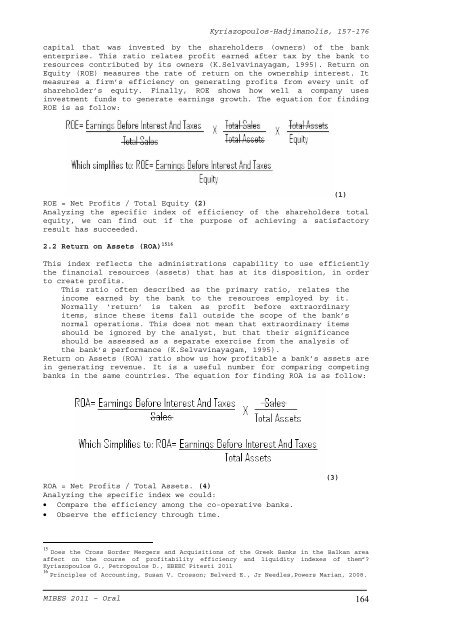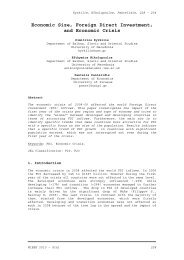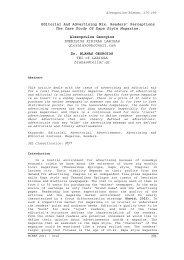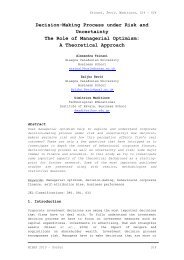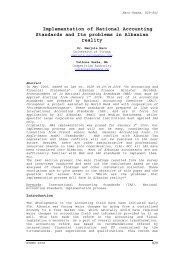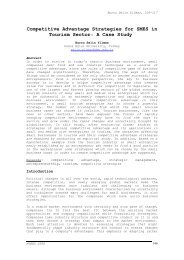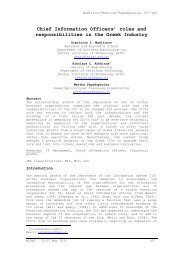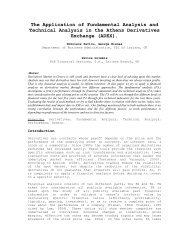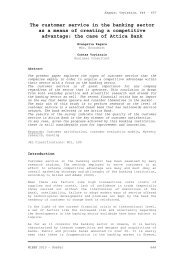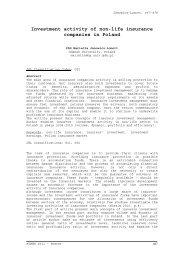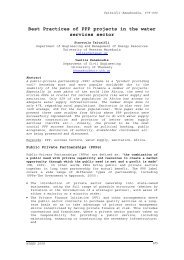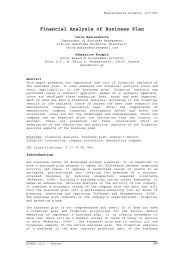Du Pont Analysis of a Bank Merger and Acquisition between ... - mibes
Du Pont Analysis of a Bank Merger and Acquisition between ... - mibes
Du Pont Analysis of a Bank Merger and Acquisition between ... - mibes
You also want an ePaper? Increase the reach of your titles
YUMPU automatically turns print PDFs into web optimized ePapers that Google loves.
Kyriazopoulos-Hadjimanolis, 157-176<br />
capital that was invested by the shareholders (owne rs) <strong>of</strong> the bank<br />
enterprise. This ratio relates pr<strong>of</strong>it earned after tax by the bank to<br />
resources contributed by its owners (K.Selvavinayag am, 1995). Return on<br />
Equity (ROE) measures the rate <strong>of</strong> return on the own ership interest. It<br />
measures a firm’s efficiency on generating pr<strong>of</strong>its from every unit <strong>of</strong><br />
shareholder’s equity. Finally, ROE shows how well a company uses<br />
investment funds to generate earnings growth. The e quation for finding<br />
ROE is as follow:<br />
ROE = Net Pr<strong>of</strong>its / Total Equity (2)<br />
Analyzing the specific index <strong>of</strong> efficiency <strong>of</strong> the s<br />
equity, we can find out if the purpose <strong>of</strong> achieving<br />
result has succeeded.<br />
(1)<br />
hareholders total<br />
a satisfactory<br />
2.2 Return on Assets (ROA)<br />
1516<br />
This index reflects the administrations capability to use efficiently<br />
the financial resources (assets) that has at its di sposition, in order<br />
to create pr<strong>of</strong>its.<br />
This ratio <strong>of</strong>ten described as the primary ratio, re lates the<br />
income earned by the bank to the resources employed by it.<br />
Normally ‘return’ is taken as pr<strong>of</strong>it before extraor dinary<br />
items, since these items fall outside the scope <strong>of</strong> the bank’s<br />
normal operations. This does not mean that extraord inary items<br />
should be ignored by the analyst, but that their si gnificance<br />
should be assessed as a separate exercise from the analysis <strong>of</strong><br />
the bank’s performance (K.Selvavinayagam, 1995).<br />
Return on Assets (ROA) ratio show us how pr<strong>of</strong>itable a bank’s assets are<br />
in generating revenue. It is a useful number for co mparing competing<br />
banks in the same countries. The equation for findi ng ROA is as follow:<br />
ROA = Net Pr<strong>of</strong>its / Total Assets. (4)<br />
Analyzing the specific index we could:<br />
• Compare the efficiency among the co-operative banks .<br />
• Observe the efficiency through time.<br />
(3)<br />
15 Does the Cross Border <strong>Merger</strong>s <strong>and</strong> <strong>Acquisition</strong>s <strong>of</strong> t he Greek <strong>Bank</strong>s in the Balkan area<br />
affect on the course <strong>of</strong> pr<strong>of</strong>itability efficiency an d liquidity indexes <strong>of</strong> them”?<br />
Kyriazopoulos G., Petropoulos D., EBEEC Pitesti 201 1<br />
16 Principles <strong>of</strong> Accounting, Susan V. Crosson; Belverd E., Jr Needles,Powers Marian, 2008.<br />
MIBES 2011 – Oral 164


